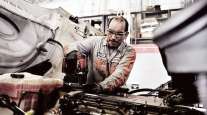Advances in Diagnostics Help Technicians Identify Problems, Streamline Repairs

[Find the latest in equipment & maintenance: Explore this quarter's issue of Calibrate]
In trucking, costly service interruptions and delays stemming from equipment problems can be reduced with the use of diagnostic repair technology, said fleet maintenance experts and vendors of systems. Plugging a laptop into a port on a truck or accessing an online service to perform diagnostic repair is a drill well-known to technicians. The technology saves time and promotes efficiency — and it can be used to do still more, experts said.
“Today, most diagnostics are used reactively,” said Tristan Nolan, product manager for Werner Technology, a division of Werner Enterprises, a carrier based in Omaha, Neb. If a driver reports a check engine light has come on, for instance, a tech uses a diagnostic portal or device “to decipher the issue,” Nolan said.
Looking to do more with diagnostics, Werner is using it in “proactive and predictive” ways, Nolan said, collaborating with vehicle OEMs and vendors such as Decisiv.
Werner announced more than a year ago that it was integrating its maintenance management software with Decisiv’s diagnostic platform. That step added 3,000 repair locations to Werner’s roster of integrated shops, expanding the list to more than 13,000, according to the announcement. Estimates are automatically uploaded.
Nolan cited another key benefit: Speeding up the maintenance processes without the need for additional phone calls. The interface between Werner’s maintenance management system and Decisiv enables changes to be visible to dealers and Werner’s maintenance team instantaneously, he said. “Speed of information is of the utmost importance in fleet maintenance,” Nolan said.
Diagnostic data has allowed maintenance associates and technicians to quickly address issues that might pose a safety risk, he added. “We receive real-time alerts related to major component failures and in many instances safely route the driver to a service location or Werner terminal before a roadside repair or tow is required,” Nolan said.

Gaining a better understanding of diagnostic data has allowed for application improvement. (Noregon Systems)
As part of its scheduled maintenance program, Werner also combines diagnostics data with historical data to prompt replacement of “consumables” such as tires and batteries.
“This helps us to reduce the number of roadside incidents for these items,” he said. From OEM systems, Werner receives predictions about major components such as aftertreatment systems, engines and transmissions. “We use those to schedule repairs while drivers are on home time,” Nolan said, reducing roadside replacements, which are more costly.
Lee Lackey, product manager for diagnostic provider Noregon, said, “Diagnostic data — when paired with service data — is a main component in the development of prognostics, which is a required technological step before we can consider advancements like autonomy.”

Host Seth Clevenger speaks with autonomous vehicle pioneer Don Burnette about the pros and cons of driverless cars and trucks. Hear the program above and at RoadSigns.TTNews.com.
Third of a three-part series on autonomous vehicles. Hear Part I here, and Part II here.
“The average commercial truck only had a couple [of electronic control units] in the mid-’90s, whereas today you’ll find more than a dozen major systems that communicate across the databus. This number is obviously going to keep growing as technology evolves in areas like advanced driver-assist systems,” he added. “It’s also important to recognize how intertwined the systems are today.” Lackey noted that once more siloed in nature, truck components now communicate with one another and, “in many instances, rely on one another to operate effectively.”
Having a better understanding of diagnostic data has allowed for the development of more effective remote diagnostic applications, Lackey pointed out. “Not all faults are created equal, so having the logic in place to provide users with pertinent information and help them ignore much of the noise” makes remote diagnostics increasingly valuable, he said. Noregon’s TripVision application can predict the likelihood of a fault escalating, Lackey said.
Willie Reeves, director of maintenance for PacLease, contrasted present-day diagnostic repair with the days “when everything was in books, with diagrams that had to be unfolded in eight different sections and spread across a toolbox.” The advent of diagnostic repair, about 25 years ago, changed how those working on trucks were viewed, Reeves said. “They went from being called ‘mechanics’ to being called ‘technicians.’ ” They had to learn how to operate the diagnostic software and interpret the information it yielded.
“The engine cut-out test was one of the most popular diagnostic features” in the early days, Reeves recalled. “This was a big step forward. Before [that], a technician had a stethoscope that they would use to detect noises and the general location of the problem.”

Industry experts say the use of diagnostic applications has increased vehicle uptime. (Noregon Systems)
Connecting a computer to a truck in a bay, Reeves said, is “a great improvement over the previous practice of holding a stethoscope in the proximity of a running engine; not the safest of diagnostic procedures.”
Vehicle uptime has increased dramatically, Reeves noted. “That is a direct result of the reduced time it now takes for a technician to troubleshoot an issue. Now, a technician can look at data being transmitted in real time while the truck is running and in motion and record the data and send it as a file to an OEM. All this information will help improve components over time. And that will translate to more uptime.”
More Q1 Calibrate
►Technology Helps Technicians Streamline Repairs
►How to Combat a Cyberattack
►Top 10 Equipment Financing Trends Face Headwinds
►Freeze: Ready for the Future
►TMC Corner: Brakes, Telematics Focus of TMC 2023
Explore the Issue!
In the meantime, some said there can be a temptation to do a workaround that results in a legitimate fix, but misses an opportunity to go deeper, using diagnostics to address the root cause of a component failure or an underlying reason for premature wearing.
“There is a very clear difference between making a repair … and solving the problem that created the need for [the] repair,” said Randy Obermeyer, vice president of safety and maintenance for OnLine Transport, and general chairman and treasurer of the Technology & Maintenance Council.
Today, when a check engine light comes on, in-house and outside repair facilities typically take standard troubleshooting steps to find the faulty component, write a quote or estimate, and submit it for approval; once approval is given they repair or replace the component and send an invoice. “At some point another similar truck is sent to another repair facility with the same issue and the process repeats,” Obermeyer said.
Obermeyer said the unanswered question is: “What caused the component to fail?” He hopes to factor component life expectancy and premature failure into diagnostics. “ ‘Prematurely’ doesn’t refer to ‘out of warranty,’ ” Obermeyer specified, but to “a typical life expectancy based on normal conditions.” Maintenance providers would also need to request from customers the component’s repair history, Obermeyer noted. The repair facility would determine why it failed, and include the cost to fix “the current issue and [its] potential cause,” Obermeyer said. The root cause and an estimate would be noted on the invoice along with a “countermeasure” designed to slow its recurrence or eliminate it.

As equipment becomes more advanced, the demand for diagnostics and trained technicians will grow. (Noregon Systems)
Obermeyer said his goals within TMC in coming years include developing a guide for teaching root cause analysis and making it a part of the curriculum at technician trade schools.
Lackey of Noregon said the vendor’s Jpro application has features called “Fault Guidance” and “Repair Mentor” that are designed to prioritize vehicle issues and guide the user to finding the root cause. “There are simply too many things that cause a vehicle or system to malfunction today, [and] it’s unrealistic to expect technicians to get by with just their knowledge alone,” Lackey said. “Electronic assistance speeds up the work and helps execute accurate, long-lasting repairs.”
Robert Nordstrom, Decisiv’s vice president of customer solutions, said that when a check engine light comes on, many people in trucking think all that needs to be done is to plug in a laptop “and it’ll tell you what’s wrong. That’s a fallacy.”
Nordstrom gave an example involving a sensor, a tank for diesel exhaust fluid and a DEF injector. The sensor could become faulty and wrongly show the tank as full. “A fault code might show there’s something wrong with the DEF injector [but] it’s actually because the tank is empty,” he said. Rather than immediately telling a tech what exactly is wrong, fault codes “lead [a tech] down a trail to what’s wrong,” Nordstrom said.
Using diagnostic technology is a learned skill that can be better understood and utilized, some experts said. Bryan Lewis, who worked as a technician and maintenance supervisor in the Walmart fleet operation for 25 years and is an educator and trainer of technicians, and a consultant with Automative Service Excellence, said users of diagnostics must decide what data is important to their operation, based on how the trucks are used and under what conditions.
Today’s diesel engines require large amounts of air to burn each gallon of fuel, Lewis said. Through data monitoring, a tech “looks at air restriction and knows when the air filter needs to be changed. And that depends on the climate you run in.”
Want more news? Listen to today's daily briefing below or go here for more info:





